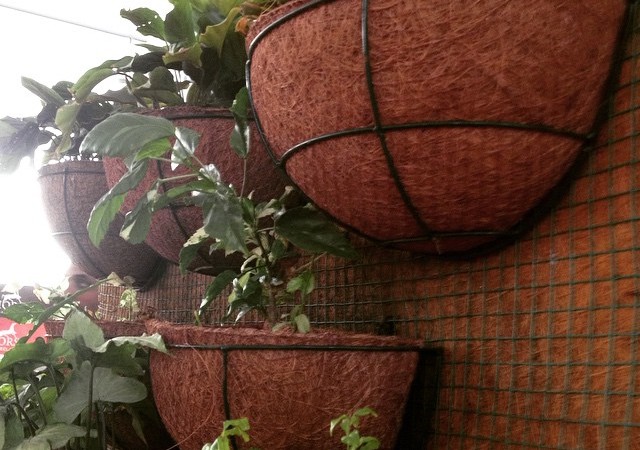 |
| Plant vases made of coir fibre and coir piths are eco-friendly and cheap. Image by Subhashish Panigrahi under CC-by-SA 4.0. |
Coir fibres make up about a third of the coconut pulp and the remaining portion, called pith or dust, is biodegradable. Coir pith used to be treated as waste material, but is now increasingly being used as soil treatment, mulch and a hydroponic growth medium, e.g. use inside the coir pot. If coir pith is artificially decomposed using biological agents, within 30 days it can convert to be 100% natural organic manure benefitting the plant.
Using coir pots that can be planted directly in the garden can save an estimated 100 million plastic pots from ending up in garbage cans.
The coconut tree (Cocus nucifera) grows in many tropical countries but is commercially exploited mainly in India, Thailand, Sri Lanka and the Philippines. Ropes and rigging made from coconut fibre have been in use from ancient times and are found in the Indian and Arab histories.
This YouTube video shows how coir is made from coconut husks:
India produces 60% of the total world supply of coir fibre. India and Sri Lanka together produce 90% of the coir produced every year across the world. India earned foreign exchange of Rs 2,200 million (approximately $37 million) by exporting coir pith during 2011-12 and aims to boost exports by five times mainly because of the demand in the Gulf countries.
One of the inventions using coir piths is the coir pot, an asset for anyone who wants to start green farming.
Seed Germination Cup or COCO POT : Coir pots are made from coir fiber blended with or without natural rubber.... pic.twitter.com/9NslaI0ySR
— Apex Coir (@ApexCoir) November 12, 2013After planting trees inside the pot, the roots grow through the coir, so the entire pot and plant can be put into the ground – no wasted plastic pot and no wasted effort.GV author Subhashish Panigrahi writes in Facebook:
Plant vases made of coir are the new export materials. Surprisingly being quite cheap these eco-friendly materials haven't found a market in India. Coir pith is used as manure in the vases. After two years or so, when the roots start penetrating the vase, it could straight away be taken and planted. What a neat idea!The benefits of coir pots are that they can replace petroleum-based plastic nursery pots, flats and trays. Although they are lightweight, durable and can be recycled, they usually wind up in the trash causing environmental damage. But things are changing. Plants in biodegradable containers such as coir pots are gradually becoming more available as growers wake up to the environmental consequences of plastics and rubbers.
Subhashish Panigrahi contributed to this post.
The post was also published in Global Voices Online.
























0 comments:
Post a Comment